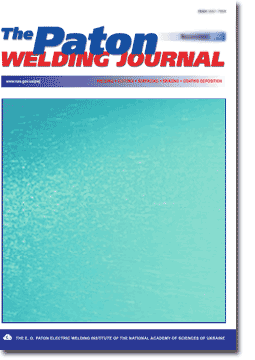| 2009 №04 (10) | 2009 №04 (02) |

TPWJ, 2009, #4, 2-7 pages
INFLUENCE OF THERMAL CONDITIONS OF WELDING ON THE FEATURES OF CRACK INITIATION IN THE HAZ OF JOINTS OF ALUMINIUM ALLOYS V96 AND V96tss
Journal The Paton Welding Journal
Publisher International Association «Welding»
ISSN 0957-798X (print)
Issue № 4, 2009 (April)
Pages 2-7
Authors
T.M. LABUR, T.G. TARANOVA, G.M. GRIGORENKO and V.A. KOSTIN
E.O. Paton Electric Welding Institute, NASU, Kiev, Ukraine
Abstract
The influence of thermal impact in nonconsumable electrode and electron beam welding on the features of cracking in different sections of the HAZ of high-strength complex-alloyed aluminium alloys V96 and V96tss at off-center tension has been analyzed. It is shown that the used temperature-time parameters of the welding mode change the volume fraction of particles contained in the alloy, their dimensions, shape and morphology of inclusion location on the boundary between the grains have an essential influence on the local stressed state in the HAZ metal and determine the associated mechanism of fracture site initiation.
Keywords: high-strength aluminium alloys, welding, nonconsumable electrode, electron beam, thermal impact, structure, heat-affected zone, off-center tension, crack initiation, fracture
Received: 15.09.08
Published: 28.04.09
References
1. (1998) Welding in aircraft construction. Ed. by B.E. Paton. Kiev: MIIVTs.
2. Ishchenko, A.Ya., Labur, T.M. (1999) Weldable aluminium alloys with scandium. Kiev: MIIVTs.
3. Labur, T.M., Taranova, T.G., Kostin, V.A. et al. (2006) Influence of structural transformations in welding of aluminium alloy V96 on fracture resistance parameters. The Paton Welding J., 11, 17-21.
4. Labur, T.M., Taranova, T.G., Kostin, V.A. et al. (2007) Nature of fracture of V96 alloy depending on heating conditions in welding. Ibid., 2, 9-15.
5. Labur, T.M., Ishchenko, A.Ya., Taranova, T.G. et al. (2007) Influence of thermophysical conditions of welding on fracture resistance of the HAZ metal in the joints of aluminium alloy V96tss. Ibid., 4, 25-30.
6. Berezina, A.L., Monastyrskaya, T.A., Chekh, E. et al. (1997) Comparative analysis of the effectiveness of Al3Sc and Al3Zr particles in Al-Mg alloys. Metallofizika i Nov. Tekhnologii, 19(9), 22-31.
7. Elagin, V.I., Zakharov, V.V., Rostova, T.D. (1994) Effect of scandium on structure and properties of alloy Al-5.5 % Zr-2.0 % Mg. Metallovedenie i Term. Obrab. Metallov, 7, 25-27.
8. Fujikawa, S. (1999) Scandium in pure aluminum and aluminium alloys - its behavior and addition effects. J. Japan Institute of Light Metals, 49(3), 361-365.
9. Davidenkov, N.N. (1981) Mechanical properties of materials and methods of measurement of deformations. Vol. 2. Kiev: Naukova Dumka.
10. (1977) Plasticity and fracture. Ed. by V.L. Kolmogorov. Moscow: Metallurgiya.
11. Klevtsov, G.V. (1993) Kinetics of formation of plastic deformation zones near the crack tip in fracture of structural materials in the plane stressed state and at plane deformation. Problemy Prochnosti, 4, 57-63.
12. Gordeeva, T.A., Zhegina, I.P. (1978) Analysis of ruptures in evaluation of material reliability. Moscow: Mashinostroenie.
13. Ivanova, V.S., Kudryashov, V.G., Shtovba, Yu.K. et al. (1974) Fractography and toughness of aluminium and titanium alloys. Tekhnologiya Lyog. Splavov, 3, 65-70.
14. (1982) Fractography and atlas of fractographs: Refer. Book. Moscow: Metallurgiya.
Suggested Citation
T.M. LABUR, T.G. TARANOVA, G.M. GRIGORENKO and V.A. KOSTIN (2009) INFLUENCE OF THERMAL CONDITIONS OF WELDING ON THE FEATURES OF CRACK INITIATION IN THE HAZ OF JOINTS OF ALUMINIUM ALLOYS V96 AND V96tss. The Paton Welding J., 04, 2-7.The cost of subscription/purchase order journals or individual articles
| Journal/Currency | Annual Set | 1 issue printed |
1 issue |
one article |
| TPWJ/USD | 384 $ | 32 $ | 26 $ | 13 $ |
| TPWJ/EUR | 348 € | 29 € | 24 € | 12 € |
| TPWJ/UAH | 7200 UAH | 600 UAH | 600 UAH | 280 UAH |
| AS/UAH | 1800 UAH | 300 UAH | 300 UAH | 150 UAH |
| AS/USD | 192 $ | 32 $ | 26 $ | 13 $ |
| AS/EUR | 180 € | 30 € | 25 € | 12 € |
| SEM/UAH | 1200 UAH | 300 UAH | 300 UAH | 150 UAH |
| SEM/USD | 128 $ | 32 $ | 26 $ | 13 $ |
| SEM/EUR | 120 € | 30 € | 25 € | 12 € |
| TDNK/UAH | 1200 UAH | 300 UAH | 300 UAH | 150 UAH |
| TDNK/USD | 128 $ | 32 $ | 26 $ | 13 $ |
| TDNK/EUR | 120 € | 30 € | 25 € | 15 € |
AS = «Automatic Welding» - 6 issues per year;
TPWJ = «PATON WELDING JOURNAL» - 12 issues per year;
SEM = «Electrometallurgy Today» - 4 issues per year;
TDNK = «Technical Diagnostics and Non-Destructive Testing» - 4 issues per year.


